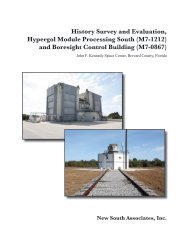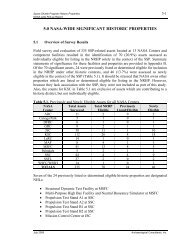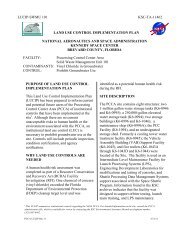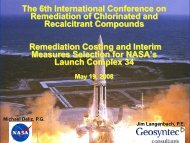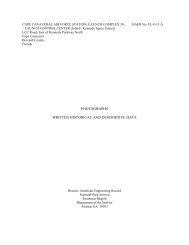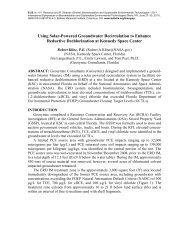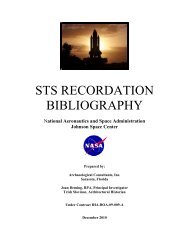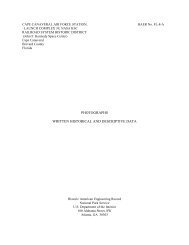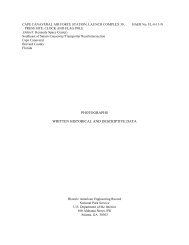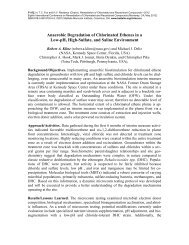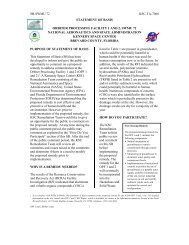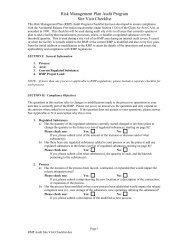john f. kennedy space center brevard county, florida - Environmental ...
john f. kennedy space center brevard county, florida - Environmental ...
john f. kennedy space center brevard county, florida - Environmental ...
Create successful ePaper yourself
Turn your PDF publications into a flip-book with our unique Google optimized e-Paper software.
overrun, a series of approach lights begins, ending 1000 feet into the actual runway. Each set of<br />
lights stands 200 feet apart. Prior to the runway, each set is comprised of five, constantly lit,<br />
above-grade fixtures and one additional sequential flasher, placed atop a junction box. Those<br />
within the runway are in-grade fixtures, so as not to hinder the aircraft. There is also a group of<br />
four xenon search lights on each side of the overrun at each end. The painted “15” and “33” at<br />
the <strong>center</strong> of the ends of the runway signal the touchdown locations for commercial aircraft using<br />
the strip. At 2500 feet from each end, there is a pair of large, black rectangles to indicate the<br />
Orbiter touchdown positions. The peripheral placement of these rectangles allows the Orbiter’s<br />
commander to see where to land. All painted features use industry standard paint containing<br />
reflective beads.<br />
Lining each side of the runway is a canal, now used mainly for animal control. These canals were<br />
originally dug to create a flat surface for the runway. Near the <strong>center</strong> of the runway, to the<br />
northeast, is the circa 2005 Air Traffic Control tower, complete with viewing stands for the press<br />
and members of the public. Also in this vicinity is the fire and rescue vehicle building. At the<br />
southeast end of the runway is a 550-foot by 490-foot parking apron. The Mate-Demate Device<br />
sits at the northeast corner of this apron, with the Landing Aids Control Building to its southeast.<br />
There is also an Orbiter Towway for the orbiter to be taken to the Orbiter Processing Facilities.<br />
In addition, numerous other navigation and landing aids lie along the runway. These include the<br />
Tactical Air Navigation (TACAN) system for range and bearing measurements when the Orbiter<br />
is up to 145,000 ft altitude and the Microwave Scanning Beam Landing System (MSBLS) for<br />
more precise guidance signals on slant range, azimuth and elevation when the orbiter is up to<br />
18,000-20,000 ft.<br />
The resource boundary extends from the outer perimeter of the Shuttle Landing Facility<br />
(Runway) approximately 10 feet, which includes the runway, its shoulders and overruns, and<br />
necessary components, such as runway lights, historically required for its functions.<br />
SIGNIFICANCE: The SLF Runway is considered eligible for listing in the NRHP in the<br />
context of the U.S. Space Shuttle Program (1969-2010) under Criterion A in the areas of Space<br />
Exploration and Transportation and under Criterion C in the area of Engineering. Because it has<br />
achieved significance within the past 50 years, Criteria Consideration G applies. In addition to its<br />
individual eligibility, the SLF Runway also is a contributing resource within the SLF Area<br />
Historic District. The period of significance for the SLF Runway is from 1976, the date of its<br />
completed construction, through 2010, the designated end of the Space Shuttle Program. The<br />
Space Shuttle Program is the longest running American <strong>space</strong> program to date. Unlike the<br />
Mercury, Gemini and Apollo programs, the emphasis was on cost effectiveness and reusability, as<br />
well as the construction of a <strong>space</strong>. The SLF Runway is significant as the site where all five<br />
orbiters originally arrived at KSC from their assembly plant in Palmdale, California. It serves as<br />
the main landing site for the Shuttle vehicle, or as a return from landing site when weather or<br />
other issues necessitated the use of Edwards AFB as the landing facility. Under Criterion C, the<br />
SLF Runway was specifically engineered for the <strong>space</strong> shuttle orbiter. The 15,000-foot length of<br />
the runway, excluding the 1,000-foot overruns at each end, was necessary due to the speed, 303<br />
mph, with which the orbiter lands. This length also makes the SLF Runway one of the longest<br />
runways in the world. In addition, the thickness of the runway, 16 inches at the <strong>center</strong> and 15<br />
inches at the sides, is necessary to accommodate the weight of the orbiter. As the primary<br />
landing site for the orbiter, the SLF runway is of exceptional importance to the Space Shuttle<br />
Program, and because it is less than 50 years in age, Criteria Consideration G applies.<br />
INTEGRITY: The SLF Runway maintains a high level of integrity with regards to location,<br />
design, setting, materials, workmanship, feeling and association.



